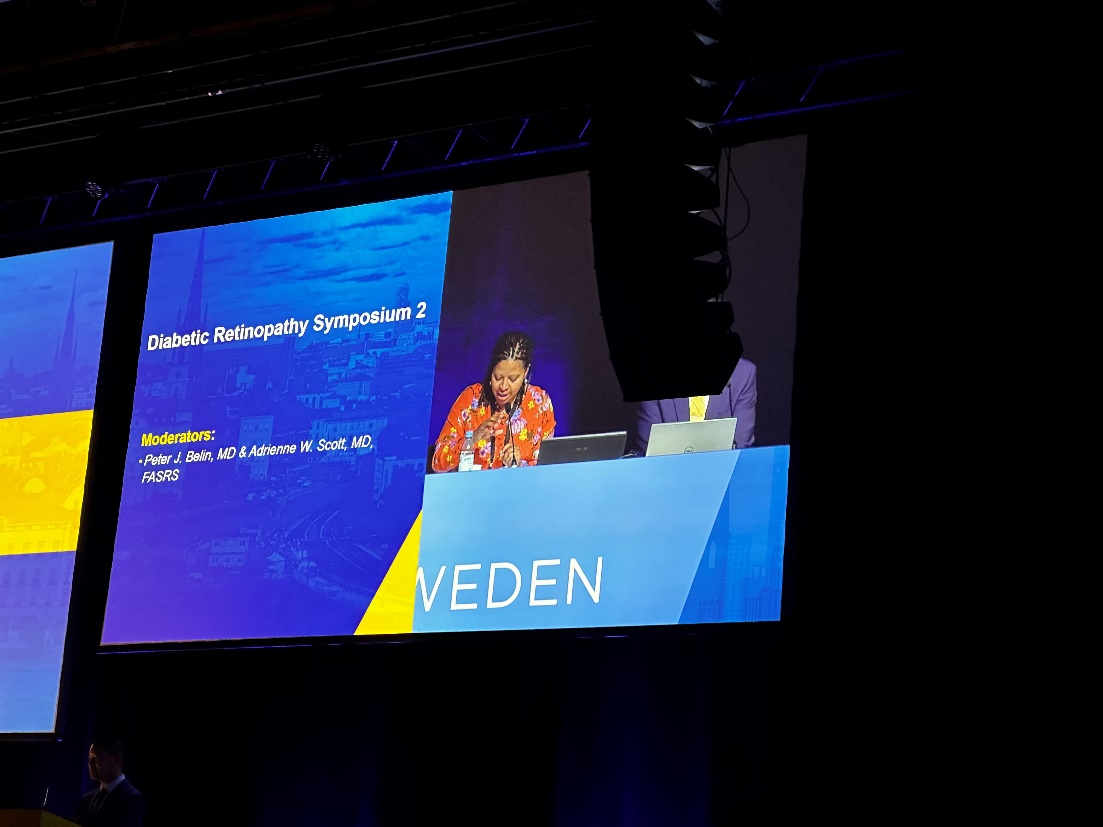Vishal Swaminathan, MD
Mayo Clinic, Rochester, MN
The Diabetic Retinopathy Symposium II at the 2024 ASRS meeting featured a great discussion on the use of various agents for the treatment of diabetic macular edema.

The session began with a presentation by Dr. Theodore Leng, MD presenting the 12-month real-world outcomes of patients with diabetic macular edema who were treated with faricimab as part of the FARETINA-DME study. The FARETINA-DME Study is an ongoing, retrospective study that uses data from the American Academy of Ophthalmology IRIS Registry database investigating injection frequency and clinical response in patients receiving faricimab for DME.
![]()
This study included 8970 eyes that had at least 12 months of follow-up and two visual acuity (VA) measurements, with 1139 (12.7%) anti-VEGF treatment naive eyes and 5406 (69%) of eyes receiving previous treatment.
The results of the study support the real-world effectiveness and durability of faricimab as a treatment modality for DME. 71.6% of eyes with recorded follow-up of 12 months or longer extended their faricimab injection treatment interval from 6 weeks or less to greater than 6 weeks within the initial 3 injections. Visual acuity and central subfield thickness improved in both the treatment-naive and previously treated groups after 7 injections of faricimab.
In the next talk, Dr. Murat Oncel, MD compared suprachoroidal triamcinolone injections and intravitreal dexamethasone implants as treatment methods for refractory diabetic macular edema in a study involving 57 eyes from 45 patients over 6 months. Outcomes included central macular thickness, best corrected visual acuity (BCVA), and development of complications such as rise in intraocular pressure or cataract development.
![]()
Both groups showed maximum CMT reduction at 1 month, corresponding with the greatest improvement in BCVA. No significant differences in BCVA or CMT were observed between the groups at baseline, 1, 3, and 6 months. Mean IOP was significantly higher in the intravitreal injection group at 1, 3, and 6 months, and cataract progression was significantly higher in this group as well. Importantly, there were no complications pertaining to elevations in IOP or cataract progression observed in the suprachoroidal injection group.
Overall, both treatment methods were effective in reducing CMT and improving BCVA, but the higher complication rate with dexamethasone implants suggests suprachoroidal triamcinolone injections may be a promising option for managing macular edema.
Next, Dr. Baruch Kuppermann MD, PhD discussed EYE-103, a novel therapy tetravalent trispecific fusion protein targeting genetic pathways involved in conditions like diabetic macular edema (DME) and neovascular age-related macular degeneration (AMD). The results of Phase 1b of the AMARONE clinical trial evaluating this protein were reported.
![]()
As a background, intact NORIN signaling upregulates beta-catenin, increasing tight junctional proteins (e.g., ZO1 and JAM) at the cell border. Loss of NORIN signaling results in reduced tight junctional proteins, causing blood-brain barrier breakdown.
The mechanism of action of EYE-103 involves binding FRIZL-4 and LRP-5 to activate the Wnt pathway, mimicking NORIN signaling. Thus, in disease processes with blood-retinal barrier breakdown, such as neovascular AMD, diabetic retinopathy, DME, and retinal vein occlusion, EYE-103 aims to restore tight junctional proteins at the cell border to resolve macular edema.
Part 1b of this trial was open label and involved dose-escalation with 12 patients (7 with DME, 5 with neovascular AMD) in which they received EYE-103 monotherapy as part of one of four sequential ascending dose cohorts and were followed up for 12 weeks with 3 monthly intravitreal injections. The primary endpoint for the 7 patients with DME was safety at 12 weeks and secondary endpoints included vision improvement. Preliminary data showed no dose-limiting toxicities, serious adverse events (SAEs), or drug-related adverse effects, with clear visual acuity improvement.
Overall, EYE-103 demonstrated promise as a treatment for DME, showing good safety, tolerability, and effectiveness.
The symposium concluded with Dr. Dilsher Dhoot, MD reporting on the safety and efficacy results for the Axitinib implant (TKI-inhibitor) from Phase 1 of the HELIOS trial for moderately-severe to severe NPDR without CI-DME.
![]()
In Phase 1 of the HELIOS trial, patients with moderately severe and severe NPDR were randomized in a 2:1 ratio of OTX-TKI to sham at baseline and followed over 52 weeks, and Dr. Dhoot presented the 48-week results. The primary outcome of the trial was the safety profile of the drug.
Overall, OTX-TKI was generally well-tolerated with no serious adverse events and demonstrated stability or improvement in Diabetic Retinopathy Severity Scale (DRSS) with durability up to 48 weeks. 23.1% of patients had a two-step improvement; 46.2% had a one-step improvement, with no patients experiencing worsening in DRSS. There were no vision-threatening complications in the OTX-TKI group.
This trial illustrates that OTX-TKI shows promise as a safe and effective treatment option for severe NPDR, offering a longer-lasting alternative with potential to improve patient outcomes and reduce the burden of frequent injections.